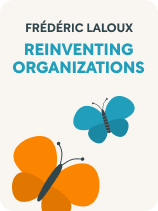

This article is an excerpt from the Shortform book guide to "Reinventing Organizations" by Frédéric Laloux. Shortform has the world's best summaries and analyses of books you should be reading.
Like this article? Sign up for a free trial here.
How are CEOs in visionary companies different from other CEOs? How should board members and investors be selected?
In Reinventing Organizations, Frédéric Laloux discusses how upper management functions in visionary companies. He explains that the role of a CEO in a visionary company is different than it is in traditional organizations. He also discusses board members and principal investors.
Keep reading to learn about Laloux’s assessment of a visionary management style.
Visionary Management Style
Laloux explains that leaders can build visionary companies (“Teal organizations”) from the ground up or transition them from older management paradigms.
Laloux says that, in a visionary management style, the CEO, the board, and principal investors buy into the concept. If that commitment can be established, then the CEO can create and maintain the space for visionary processes to develop, while holding back the pressures that will try to fit the company into a top-down hierarchical structure. (Shortform note: In Good to Great, Jim Collins expands this idea to include everyone on the management team. He argues that the right people have to be in place before change can occur and that those involved in company leadership need to see themselves as a group of equals working toward a common purpose.)
Laloux stresses that, in visionary organizations, the role of the CEO differs greatly from that in other institutions. While the CEO acts as the company’s public face, their job is to refrain from using power. Instead, CEOs should model visionary principles, such as going through the advice process before making decisions, being transparent in communications, and holding themselves accountable. The CEO must bring their whole, authentic self to the workplace, even though that means showing vulnerability and not hiding behind a managerial demeanor.
The role of leadership in enabling visionary practices is so crucial that Laloux identifies the mindset of the CEO as a necessary precondition for all that follows while admitting that resisting the urge to take charge is the hardest part of the job for business leaders to accept. Trusting staff to make broad-ranging decisions is so counter to modern culture that the CEO must affirm it continually by acting as an advisor only, not relying on traditional mechanisms of power.
| Leading From Vulnerability By demoting the CEO to a kind of organizational figurehead, Laloux’s ideas are pretty far from mainstream. In The 21 Irrefutable Laws of Leadership, John C. Maxwell presents a more traditional view—that people follow leaders, not visionary ideals, and that strength, character, and respect are paramount. However, in Dare To Lead, Brené Brown says that vulnerability is the defining characteristic of courageous leadership. Being vulnerable lets leaders engage in difficult conversations with honesty and clarity, reduces their emotional reactivity, and enables them to build trust with the whole organization. It also helps the organization develop failure resistance if the CEO normalizes failure and lets employees know they’ll be supported for taking risks. Failure is so important to learning that Ryan Holiday (in The Obstacle Is the Way) says you should encourage small, frequent risks in order to fail as soon as possible while minimizing the cost to individuals or the organization. |
Aside from describing the ideal CEO, Laloux also insists that visionary companies be very selective about who serves on their boards. They will have to understand the organization’s higher purpose and not put pressure on the organization to please investors to the detriment of following the company’s higher calling. Investors who share the organization’s values may be difficult to find, but in the long run, they’ll support the company’s mission.
(Shortform note: Creative management decisions may be needed to maintain a company’s vision through future changes in leadership. In 2022, Patagonia founder Yvon Chouinard gave his $3 billion company to a nonprofit trust instead of selling to investors, ensuring that all of Patagonia’s future profits would be used to fight climate change and protect undeveloped land. This unconventional move had the added benefit of letting Chouinard’s family maintain an interest in the company while avoiding the taxes they’d have owed had they sold it.)
Exercise: Get Ready to Manage Yourself
Laloux asserts that employee self-management will be an essential part of the next stage of organizational development. If you’re self-employed or have ever worked from home, you’ve already experienced self-management to some extent. Compare self-management as described in this book to jobs in which you’ve worked under direct supervision.
- Do you feel more comfortable managing yourself or receiving direction from others? Describe a situation in which making a crucial decision about your job either caused you stress, made you feel empowered, or both at the same time.
- If you were to be completely in charge of your schedule, how would you plan your typical work day? Would you coordinate any of your activities with others?

———End of Preview———
Like what you just read? Read the rest of the world's best book summary and analysis of Frédéric Laloux's "Reinventing Organizations" at Shortform.
Here's what you'll find in our full Reinventing Organizations summary:
- The practices and values that are inherent in the next level of human organization
- A look at the paradigm shifts in organizational structure over the past 10,000 years
- How to implement visionary practices at your company






